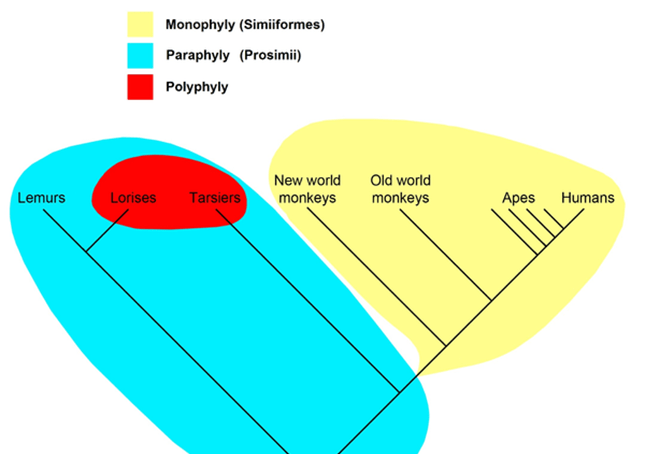Cladistics

Cladistics (/kləˈdɪstɪks/, from Greek κλάδος, kládos, “branch”) is an approach to biological classification in which organisms are categorized in groups (“clades”) based on hypotheses of most recent common ancestry. The evidence for hypothesized relationships is typically shared derived characteristics (synapomorphies) that are not present in more distant groups and ancestors.
Theoretically, a common ancestor and all its descendants are part of the clade, however, from an empirical perspective, common ancestors are inferences based on a cladistic hypothesis of relationships of taxa whose character states can be observed. Importantly, all descendants stay in their overarching ancestral clade. For example, if within a strict cladistic framework the terms worms or fishes were used, these terms would include humans.
Many of these terms are normally used paraphyletically, outside of cladistics, e.g. as a ‘grade’. Radiation results in the generation of new subclades by bifurcation, but in practice sexual hybridization may blur very closely related groupings.
The techniques and nomenclature of cladistics have been applied to disciplines other than biology.
Cladistics is now the most commonly used method to classify organisms.
The original methods used in cladistic analysis and the school of taxonomy derived from the work of the German entomologist Willi Hennig, who referred to it as phylogenetic systematics (also the title of his 1966 book); the terms “cladistics” and “clade” were popularized by other researchers. Cladistics in the original sense refers to a particular set of methods used in phylogenetic analysis, although it is now sometimes used to refer to the whole field.
What is now called the cladistic method appeared as early as 1901 with a work by Peter Chalmers Mitchell for birds[8][9] and subsequently by Robert John Tillyard (for insects) in 1921,[10] and W. Zimmermann (for plants) in 1943.[11] The term “clade” was introduced in 1958 by Julian Huxley after having been coined by Lucien Cuénot in 1940,[12] “cladogenesis” in 1958,[13] “cladistic” by Arthur Cain and Harrison in 1960,[14] “cladist” (for an adherent of Hennig’s school) by Ernst Mayr in 1965,[15] and “cladistics” in 1966.[13] Hennig referred to his own approach as “phylogenetic systematics”. From the time of his original formulation until the end of the 1970s, cladistics competed as an analytical and philosophical approach to systematics with phenetics and so-called evolutionary taxonomy. Phenetics was championed at this time by the numerical taxonomists Peter Sneath and Robert Sokal, and evolutionary taxonomy by Ernst Mayr.
Originally conceived, if only in essence, by Willi Hennig in a book published in 1950, cladistics did not flourish until its translation into English in 1966 (Lewin 1997). Today, cladistics is the most popular method for inferring phylogenetic trees from morphological data.
In the 1990s, the development of effective polymerase chain reaction techniques allowed the application of cladistic methods to biochemical and molecular genetic traits of organisms, vastly expanding the amount of data available for phylogenetics. At the same time, cladistics rapidly became popular in evolutionary biology, because computers made it possible to process large quantities of data about organisms and their characteristics.
